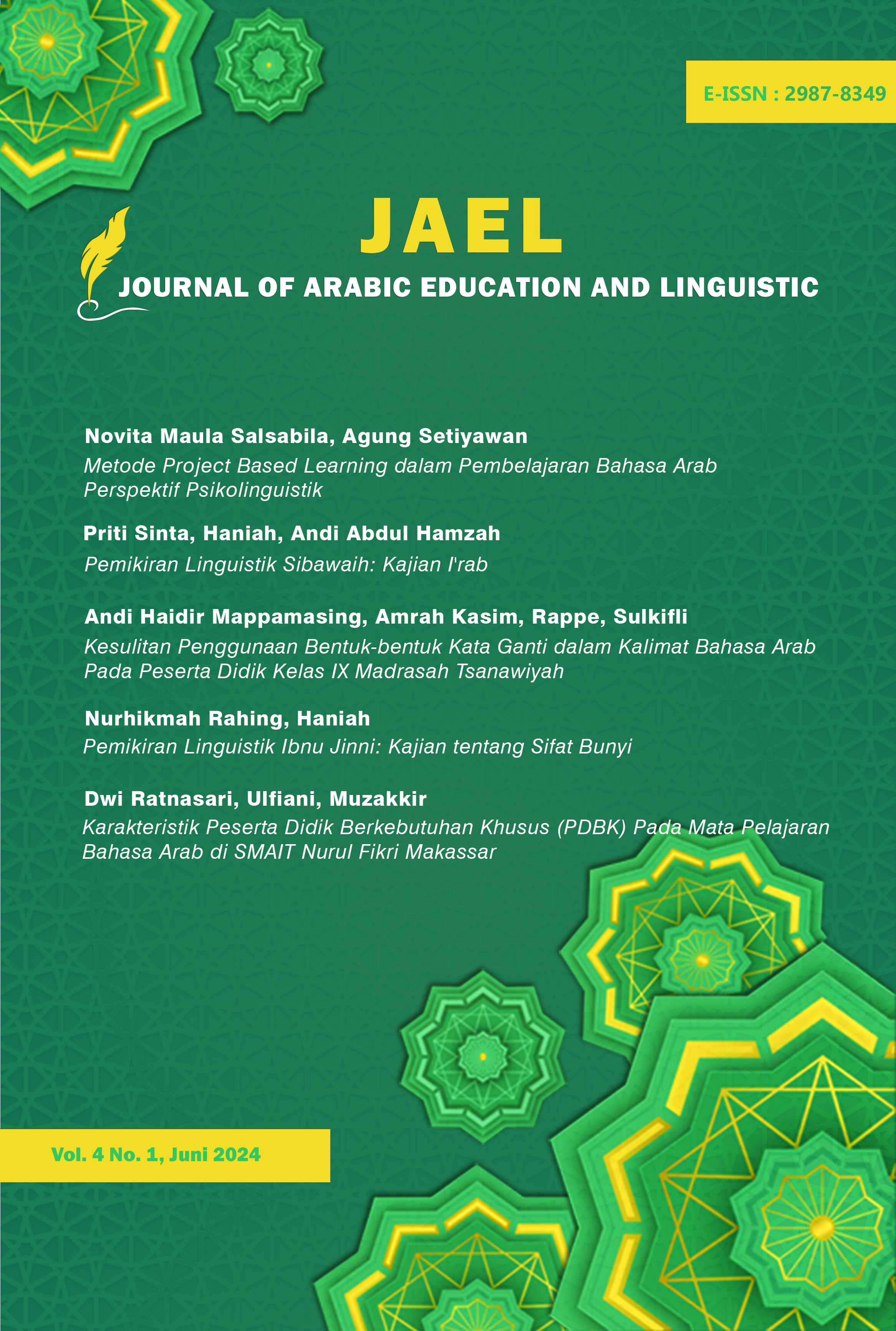Karakteristik Peserta Didik Berkebutuhan Khusus (PDBK) Pada Mata Pelajaran Bahasa Arab di SMAIT Nurul Fikri Makassar
Abstract
The purpose of this research is to describe the condition of Students with Special Needs (PDBK) at SMAIT Nurul Fikri Makassar based on their characteristics. The type of research is descriptive qualitative. The data source of this research uses primary data (students, Arabic language subject teachers or special mentor teachers, and school principals) and secondary data such as the results of interview notes with teachers, books related to students with special needs and Arabic language books, and the results of field notes and other data that can be used as complementary data. Furthermore, the data collection methods used are observation methods, interview methods, and documentation methods. Research instruments in the form of observation guidelines and interview guidelines. Data management techniques are data collection, data transcription, data classification, data interpretation, and data description. While data analysis in this study is to review all available data from various sources, reduce data, compile it, and check data validity using source triangulation. The results of the research, regarding the condition of students with special needs at SMAIT Nurul Fikri Makassar, concluded that of the 9 PDBK students at SMAIT, two of them following the regular curriculum, three of them Omisi, thre of them subtituted, and one of them Omisi and subtituted. The implications of this research are Schools should select educators who not only have an educational background but also have experience or knowledge in the field of PDBK education, especially for GPK. In addition, it should organize PDBK education trainings for teachers who have not mastered the ability to manage or deal with PDBK. Teachers should determine a special strategy for teaching PDBK, because their ability to capture material is different from children in general.
References
Alwasilah, Chaaedar, Metodologi Pembelajaran Bahasa Arab. Bandung: PT Remaja Rosdakarya, 2011.
Bahri, Syaiful, ‘Manajemen Pendidikan Inklusi Di Sekolah Dasar’, Jurnal Ilmu Pendidikan, 2.6 (2022), 94–100 <https://doi.org/10.58578/arzusin.v2i6.703>
Farah Arriani, Agustiawati, Alifia Rizki, Ranti Widiyanti, ‘Panduan Pelaksanaan Pendidikan Inklusif’, EduHumaniora Jurnal Pendidikan Dasar Kampus Cibiru, 2.1 (2022), 50 <https://proceeding.dharmawangsa.ac.id/index.php/PFAI/article/view/17>
———, ‘Panduan Pelaksanaan Pendidikan Inklusif’, 2021
Irma Rachmayantia, Mochamad Arifin Alatas, ‘The Learning of Arabic Alphabets for Special Needs Students in Elementary School’, 3 (2020), 79–94 <https://doi.org/https://doi.org/10.22219/jiz.v3i2.11931>
Jayadi, and Asep Supena, ‘Implementasi Pendidikan Inklusi Di SDN K1 Kabupaten Karawang’, AKSARA: Jurnal Ilmu Pendidikan Nonformal, 09.(1) January (2023), 725–736 <https://doi.org/https://doi.org/10.31004/basicedu.v5i3.886>
Mangunsong, Frieda, Psikologi Dan Pendidikan Anak Berkebutuhan Khusus. Jakarta: Universitas Indonesia Press, 2009.
Nurwan, Tryas Wardani, ‘Implementasi Kebijakan Pendidikan Inklusif Di Sekolah Dasar’, JESS (Journal of Education on Social Science), 3.2 (2019), 201 <https://doi.org/10.24036/jess/vol3-iss2/176>
Padurean, Alina Nicoleta, ‘Teaching English to Children with Special Educational Needs’, Neofilolog, 3.58 (2022), 257–61 <https://doi.org/10.14746/n.2022.58.2.8>
Susilo Adi, Sugeng, Frida Unsiah, and Darin Fadhilah, ‘Teaching Special Students: English Lessons for Deaf Students in Indonesian Special Junior High Schools’, International Journal of Education and Research, 5.12 (2017), 121–136
Widodo, Arif, et al. "Analisis Gaya Belajar Siswa ADHD (Attention Deficit Hyperactivity Disorder) di Madrasah Inklusi Lombok Barat." Jurnal Bidang Pendidikan Dasar 4.2 (2020): 145-154.


 This work is licensed under
This work is licensed under